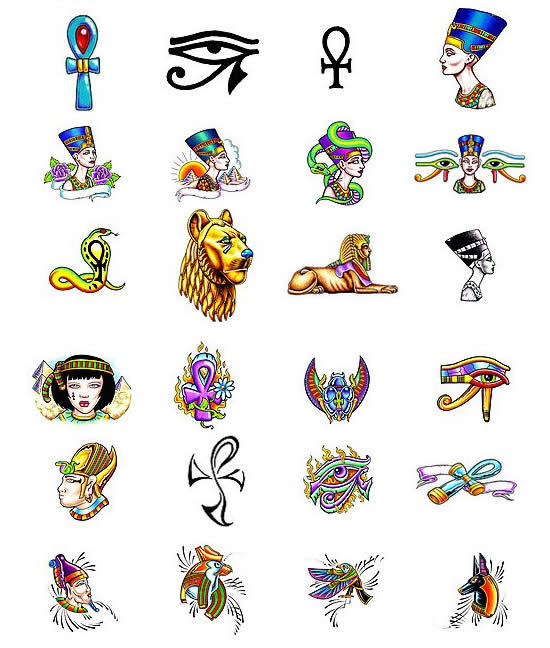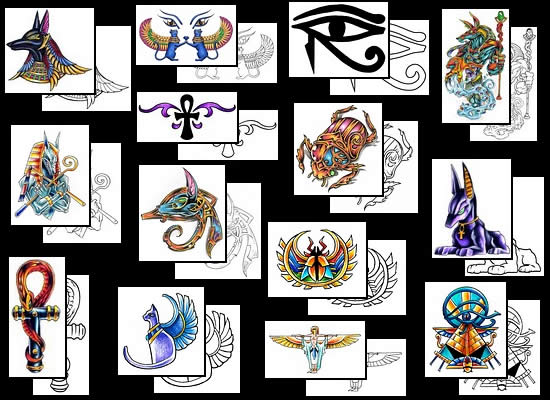 |
|||
 |
|||
|
TATTOO DESIGNS & SYMBOLS - EGYPTIAN TATTOOS
Tattoo Symbol Index - A B C D E F G H I J K L M N O P Q R S T U V W X Y Z Tattoo designs - E >> Egyptian
Some investigators were even convinced that each symbol represented an abstract concept that transcended language -- from symbol directly to thought. Such extravagant and hyberbolic speculation cloaked the hieroglyphs in ever more mystery, and perhaps explains why they show up as the chosen script for the most exotic text tattoos. Hieroglyphs were generally written from right to left, although left to right worked just as well, as did top to bottom. The direction the glyphs faced - a bird looking left, for example - showed the reader how to proceed. Words weren't demarcated by spaces or punctuation, although some glyphs served as word-endings. Two basic types of hieroglyphs rendered the Ancient Egyptian language into text - logograms and phonograms. Logograms (sometimes called ideograms) stand for the object they clearly represent - an eye is an eye, for example - and these were the most frequently used common nouns. Phonograms are phonetic, meaning that they represent sounds, in the style of most alphabets. Some symbols had a dual purpose -- 'mouth' for instance -- which also represented the 'R' sound. Other signs in the system are called determinatives. They were mute characters located at the end of a word, which gave the reader a clue to the word's meaning. Most hieroglyphic words were comprised of phonetic signs followed by one determinative. The hieroglyphic script had a clumsy system for numbers and no vowels, but it contained 24 symbols standing for single consonants, and these might have sufficed to construct every word in the language, had Egyptians not continued to employ hundreds of other symbols and ideograms, ensuring that their writing system remained complex, never to evolve into a true alphabet. It's not known what influenced the Egyptians in their choice of writing system, but it's believed that the hieroglyphs inspired later alphabets that evolved into the Phoenician, Hebrew, and Greek alphabets, the ancestors of nearly all modern languages.
Much of our fascination with the hieroglyphs stems from the mystery of their meaning. Until the turn of the 19th century, there was no consensus on whether the hieroglyphs were even a proper writing system. No one broke the code until Napoleon's troops, campaigning in Egypt in 1799, discovered the Rosetta Stone. It was inscribed with a hieroglyphic text translated twice, once into Greek and again into a common Egyptian dialect. The hieroglyphs, it turned out, were indeed a bona fide writing system. The hieroglyphs were a formal script reserved for monuments and for religious and political edicts, while 'hieratic' was used for everyday writing with ink on papyrus. In hieratic, pictorial representations got reduced to lines and squiggles, so they weren't true hieroglyphs. A third script called 'demotic' was more highly cursive (linked letters) and served as the secular writing medium. These scripts never migrated beyond Egypt's borders, nor did Egypt's conquerors bother to learn them, so that with the Roman invasion of 30 BC, the future of hieroglyphs looked dim. When the Christian Emperor, Theodosius, closed all of Egypt's pagan temples in 391 AD, the hieroglyphs were officially assigned to oblivion. The last known hieroglyphic inscription was carved into the gate of Hadrian, sometime around 394 AD.
As symbols, the hieroglyphs continue to be meaningful signs to many people today, particularly as a talisman or amulet, and most especially as tattoos. The Ankh hieroglyph, which symbolized 'life' or 'the breath of life', has become an especially popular tattoo design. It appeared prominently in many ancient Egyptian temple artworks. In one such painting, Isis is seen holding the ankh sign in front of the mummy of a deceased member of the royal family. As the Christian era eclipsed that of ancient Egypt, the pagan ankh was adopted by the Egyptian Copts as their own unique crux ansata (cross with a handle). It became the crucifix symbol in the Coptic Church, representing the hope of future life and resurrection, and at the same time acknowledging the link to previous religions and beliefs of Egypt. In later years, it came to be known as the Egyptian Cross and the 'key of life', its key-like shape inspiring the belief that it could unlock the gates of death. With so many associations, it's not surprising that it's a favoured tattoo charm. Egyptologists still puzzle over the ankh's precise origins, since it's a hybrid of two nearly universal symbols, the cross and the circle. The loop suggests the sunrise, the sun rising over the horizon - the crossbar - with the vertical line representing the path of the sun. One theory holds that it represents the gods Osiris and Isis, male and female. The cross depicts the phallus and testicles, while the oval signifies the womb. Joined together, the cross and circle represent the union of heaven and earth. The ankh has also been called the 'belt-buckle' of Isis. The ankh has also been called, the 'sandal strap', if you visualize the loop wrapped around the ankle. The ankh also symbolized the water used in purification rituals. Metal mirrors were occasionally ankh-shaped, perhaps to reflect the belief that life and death mirror each other. Today the ankh is a favourite with Neo-pagan spiritual groups. This ancient symbol is sometimes blended with theological concepts, even appearing as part of the sacred seal in the occult world. Its long history and association with life and death and the hereafter have made it popular in the world of fantasy fiction, video games and comics, especially with Goth overtones. Another hieroglyph, the Eye of Horus, was an all-seeing eye, the eye of the god Horus, also known as Ra, the Sky God with the head of a falcon, who was attributed with qualities of light and goodness. Amulets in the shape of the eye were often found in royal tombs for protection in the afterlife. The eye also signified royal power. The ancients believed it to be a symbol of indestructibility that would assist in rebirth. The sign of the eye was found under the 12th layer of bandages on Tutankhamun's mummy. The more recent tradition of freemasonry adopted the symbol, as did the United States as an element on its Great Seal, where it appears on the reverse side atop a pyramid as the Eye of Providence. The Eye of Horus also shows up in Buddhism as the 'Eye of the World', implying the enlightened perspective of Buddha, himself. Ancient sailors in the Mediterranean region were said to have painted the eye on their vessel's bow to ensure a safe voyage. The Scarab has found immortality as one of the favourite icons of Egyptian mythology and pseudo-Egyptian art. As a hieroglyph, this humble dung beetle represented Khepry, the Egyptian god of the rising sun. (Khephry is another version of the sun god, Ra). It also denoted 'becoming' or 'manifesting', due to beliefs about its own 'birth'. The ancients thought that the scarab spontaneously came to life from dung heaps, that males incubated their own semen in balls of dung, which they then rolled around in imitation of Khephry rolling the sun across the sky. So, the scarab became a symbol of genesis, rebirth, and the eternal life force in the mythology of ancient Egypt. Scarab amulets and funerary pendants symbolized, among other things, cyclical renewal. Early Christians turned it into a symbol of the resurrection. The scarab hieroglyph was often used by the pharaohs as one of their many royal titles, including the famous boy-king, Tutankhamun.
Like our infinity sign, the shen-ring hieroglyph represents that which cannot be expressed by numbers. It looks like a circle with a straight line running tangentially to its bottom edge. It was meant to be a looped rope with the excess at each end sticking out horizontally. The symbol perfectly represented ancient Egypt's dual concept of time - the circle suggesting cyclical events such as the flooding of the Nile, and the straight line heading to eternity. Among the shen-ring's other meanings were 'all that the sun surrounds', and 'protection from the all-surrounding chaos'. The shen-ring's protective power was employed as a 'cartouche' to encircle the names of royalty. The shape was necessarily elongated to accommodate the many titles in the pharaoh's name.
Get inspired by some really amazing images and photos in our Egyptian Inspiration Gallery See also: Ankh, Eye of Horus, Scarab Beetle Tattoo, Egyptian Tattoo Index
Choose your own
classic Egyptian tattoo designs at Tattoo-Art.com Choose your own Egyptian tattoo from hundreds of different Egyptian tattoo designs by some of the world's top tattoo artists and illustrators at Tattoo Johnny. Tattoo designs - E >> Egyptian Tattoo Symbol Index - A B C D E F G H I J K L M N O P Q R S T U V W X Y Z |
||
| Celeb Tattoos | Facts & Stats | Designs & Symbols | History | Culture | Links | Tattoo Galleries | Contact | |||
|
|
|||


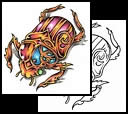
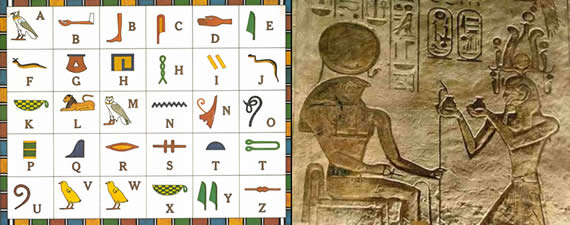
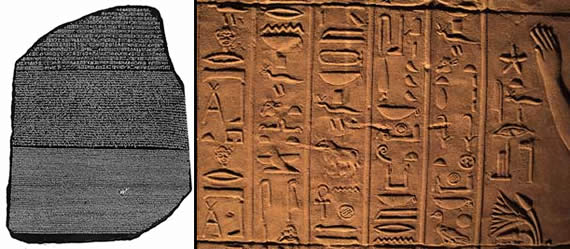
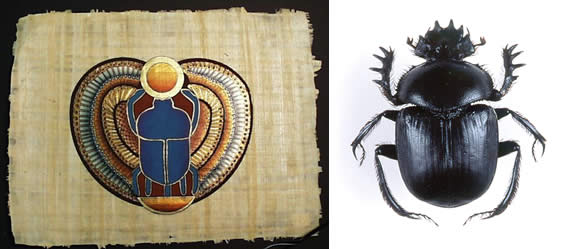
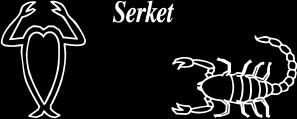 Serket, the scorpion ideogram, is one of the earliest of the
Egyptian hieroglyphs. Potentially dangerous forces of nature like
the serpent and scorpion tend to get idolized, just as they do in
tattoo culture. As well as representing itself, a scorpion, Serket
was symbolic of the Serket goddess, one of four goddesses who
protected coffins. An early Egyptian warrior king called 'Scorpion'
was featured the Hollywood film, "The Scorpion King" and its sequel.
As an element of hieroglyphic text, the serket was used as an
unvoiced determinative, suggesting 'to breathe', or 'to sniff the
wind'. The image was also put to work on Egyptian amulets as
protection and healing power against scorpion stings and snake
bites.
Serket, the scorpion ideogram, is one of the earliest of the
Egyptian hieroglyphs. Potentially dangerous forces of nature like
the serpent and scorpion tend to get idolized, just as they do in
tattoo culture. As well as representing itself, a scorpion, Serket
was symbolic of the Serket goddess, one of four goddesses who
protected coffins. An early Egyptian warrior king called 'Scorpion'
was featured the Hollywood film, "The Scorpion King" and its sequel.
As an element of hieroglyphic text, the serket was used as an
unvoiced determinative, suggesting 'to breathe', or 'to sniff the
wind'. The image was also put to work on Egyptian amulets as
protection and healing power against scorpion stings and snake
bites.